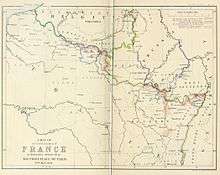Treaty of Paris (1814)


The Treaty of Paris, signed on 30 May 1814, ended the war between France and the Sixth Coalition, part of the Napoleonic Wars, following an armistice signed on 23 April between Charles, Count of Artois, and the allies.[1] It established peace between France and the United Kingdom of Great Britain and Ireland, Russia, Austria, and Prussia, who in March had defined their common war aim in Chaumont.[2] The Treaty was also signed by Portugal and Sweden while Spain signed signed shortly after in July.[3] Peace talks had started on 9 May between Talleyrand, who negotiated with the allies of Chaumont on behalf of the exiled Bourbon king Louis XVIII of France. The allies had agreed to reduce France to her 1792 borders and restore the independence of her neighbors after Napoleon Bonaparte's defeat.[2] However, the allied parties did not sign a common document, but instead concluded separate treaties with France allowing for specific amendments.[3]
In addition to the cessation of hostilities, the treaty provided a rough draft of a final settlement, which according to article 32 was to be concluded within the next two months at a congress involving all belligerents of the Napoleonic Wars.[4] This provision resulted in the Congress of Vienna, held between September 1814 and June 1815.[5] The preliminary conditions already agreed on in Paris were moderate for France to not disturb the re-enthronement of the returned Bourbon king: France's borders of 1 June 1792 were confirmed, and in addition, she was allowed to retain Saarbrücken, Saarlouis, Landau, the County of Montbéliard, part of Savoy with Annecy and Chambéry, also Avignon and the Comtat Venaissin as well as artifacts acquired during the war, while on the other hand she had to cede several colonies.[2]
To distinguish this agreement from a second treaty of Paris, concluded on 20 November 1815 as one of the treaties amending Vienna[6] the treaty of 30 May 1814 is sometimes referred to as the First Peace of Paris.[2][4]
Terms of the treaty
The treaty reapportioned several territories amongst various countries. Most notably, France retained all of the territory which it possessed as of 1 January 1792, and also was returned many of the territories lost to Britain during the war. These included Guadeloupe, which had been ceded to Sweden by Britain when she entered the coalition. In return, Sweden was compensated 24 million francs and this money gave rise to the Guadeloupe Fund. The only exceptions to this were Tobago, St. Lucia, Seychelles and Mauritius. Great Britain kept sovereignty over the island of Malta.[7] The treaty returned to Spain the territory of San Domingo that had been transferred to France by the Treaty of Basel in 1795. This implicitly recognised French sovereignty over Saint-Domingue, which Dessalines had proclaimed independent under the name of Haiti. France only recognised the independence of Haiti in 1838.
The treaty also reinstated the Bourbon monarchy in France, in the person of Louis XVIII.
The treaty also aimed to abolish the French slave trade, but not slavery, over a five-year period, and formally recognized the independence of Switzerland.[8]
Effect and aftermath
Several powers, despite the peaceful intentions of the treaty, still feared a reassertion of French power. With this in mind, the territories strengthened themselves for protection. The House of Orange, which united Belgium and the Netherlands, was created to strengthen the two aforementioned countries in case of a French attack. Many German states had been consolidated by Napoleon, and they retained this status, while Prussia gained territory in western Germany, near the border with France. In Italy, several different political entities were recognized, and the neutrality of Switzerland was formally recognized.
See also
Notes
- ↑ Büsch 1992, p. 72.
- 1 2 3 4 Malettke 2009, p. 66.
- 1 2 Büsch 1992, p. 73.
- 1 2 Büsch 1992, pp. 73–74.
- ↑ Büsch 1992, p. 74.
- ↑ Büsch 1992, p. 81.
- ↑ Rudolf & Berg 2010, p. 11
- ↑ EB staff 2014.
References
- EB staff (2014). "Treaties of Paris (1814-1815)". Britannica Online Encyclopedia.
- Büsch, Otto (1992). Handbuch der preußischen Geschichte (in German). 3. Walter de Gruyter. pp. 72–74,81. ISBN 3-11-008322-1.
- Malettke, Klaus (2009). Die Bourbonen 3. Von Ludwig XVIII. bis zu den Grafen von Paris (1814-1848) (in German). 3. Kohlhammer. p. 66. ISBN 3-17-020584-6.
- Rudolf, Uwe Jens; Berg, W. G. (2010). Historical Dictionary of Malta. USA: Scarecrow Press. p. 11. ISBN 9780810853171.
- Alexander Rich, Gisela Gledhill, and Dr. Jerzy Kierkuć-Bieliński; (2014) Peace Breaks Out! London and Paris in the Summer of 1814, London: Sir John Soane’s Museum, in print
External links
| Wikimedia Commons has media related to Treaty of Paris, 1814. |
| Wikisource has original text related to this article: |